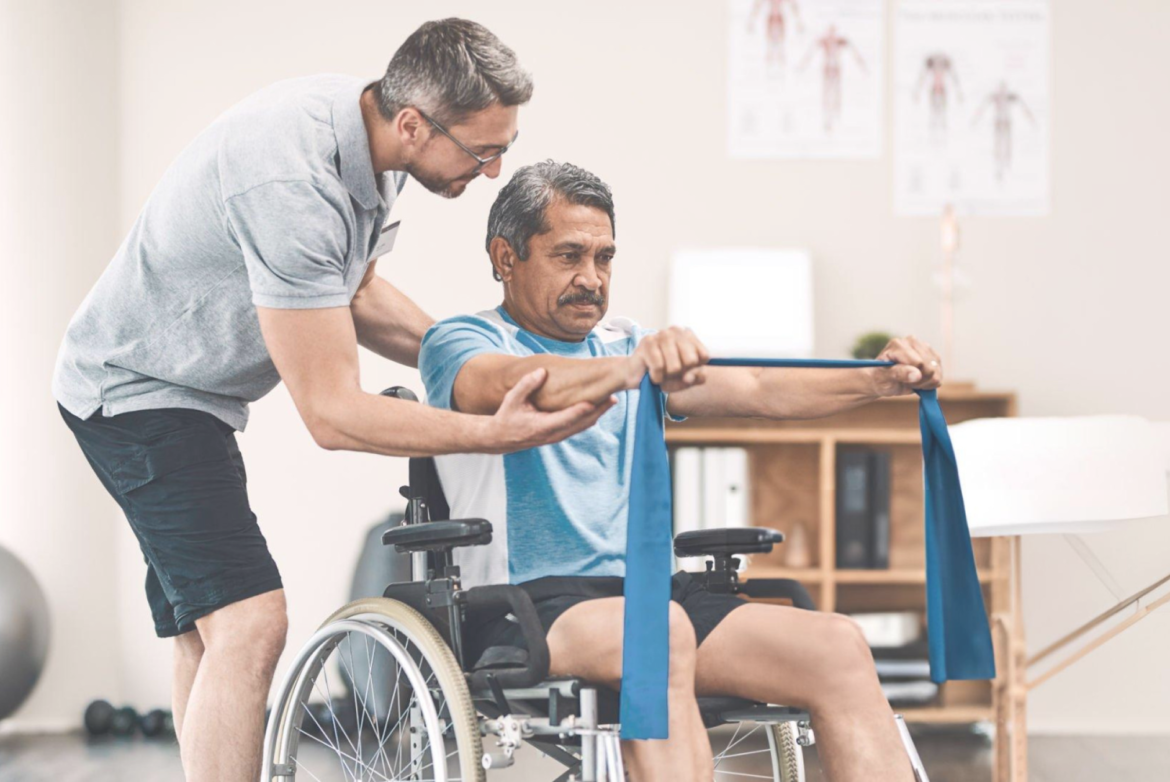Let’s Understand the Vital Role of Physical Therapy in the Rehabilitation and Management of Paralysis
Introduction
At Brar’s Physio Care, the sun shone brightly through the large windows of the therapy room, casting a warm glow on the equipment. The air buzzed with determination and hope as patients and therapists worked together to overcome the challenges of paralysis.
Our physiotherapy centre in Mohali, renowned for its exceptional care and advanced treatment techniques, has been a beacon of hope for many, providing specialized care for paralysis treatment.
The Importance of Physical Therapy in Paralysis Rehabilitation
Understanding Paralysis
Paralysis is the loss of muscle function in part of the body. It can occur due to various reasons, including stroke, spinal cord injury, traumatic brain injury, multiple sclerosis, and other neurological conditions. The impact of paralysis is profound, affecting mobility, independence, and overall quality of life.
The Role of Physical Therapy
Physical therapy (PT) plays a crucial role in the rehabilitation and management of paralysis. It involves a range of treatments and exercises designed to enhance movement, strengthen muscles, and improve functional abilities. Here’s how PT makes a significant difference:
- Improves Mobility and Flexibility:
- Regular physical therapy helps prevent muscle atrophy and joint stiffness. Studies have shown that early intervention can significantly improve mobility outcomes in paralysis patients.
- Enhances Strength and Endurance:
-
- Tailored exercises aimed at strengthening muscles help patients regain control and power. A study published in the Journal of Rehabilitation Research and Development highlighted that strength training improved muscle strength and overall function in spinal cord injury patients.
- Promotes Neuroplasticity:
-
- Neuroplasticity refers to the brain’s ability to reorganize itself by forming new neural connections. PT encourages neuroplasticity through repetitive, task-specific training, aiding in the recovery of motor skills.
- Prevents Secondary Complications:
- Regular PT can prevent complications such as pressure sores, deep vein thrombosis, and respiratory issues, which are common in immobilized patients.
- Boosts Psychological Well-being:
- Physical activity has been shown to reduce depression and anxiety, which are common among paralysis patients. Engaging in PT provides a sense of accomplishment and improves mental health.
Statistics and Scientific Data
- According to the National Institute of Neurological Disorders and Stroke (NINDS), approximately 795,000 people suffer a stroke each year in the United States, with many experiencing some form of paralysis.
- A study published in Neuro Rehabilitation and Neural Repair found that intensive physical therapy significantly improved walking ability in stroke patients.
- The World Health Organization (WHO) reports that up to 500,000 people suffer a spinal cord injury each year globally, and physical therapy is a cornerstone of their rehabilitation.
Excellence in Paralysis Treatment in Mohali:
Brar’s Physio Care stands out as the best physiotherapy centre in Mohali for paralysis treatment. The clinic offers:
- Personalized Treatment Plans: Each patient receives a customized rehabilitation plan tailored to their needs and goals.
- Advanced Facilities: Equipped with the latest technology and equipment to provide the best possible care.
- Experienced Therapists: A team of highly trained and experienced physiotherapists dedicated to helping patients regain their independence.
- Holistic Approach: Combining physical therapy with nutritional advice, psychological support, and lifestyle modifications for comprehensive care.
Specific advanced treatment techniques do Brar’s Physio Care use for paralysis rehabilitation
We employ a variety of advanced treatment techniques for paralysis treatment in Mohali, designed to enhance recovery and improve the quality of life for patients. Here are some of the key techniques used:
- Neurodevelopmental Treatment (NDT)
- Description: NDT focuses on improving the motor skills of patients by facilitating normal movement patterns and inhibiting abnormal muscle tone and reflexes. It is particularly effective for patients with stroke and cerebral palsy.
- Benefits: Enhances muscle control, coordination, and balance.
- Constraint-Induced Movement Therapy (CIMT)
- Description: CIMT involves restricting the use of the unaffected limb, thereby forcing the patient to use the affected limb more frequently. This technique promotes neuroplasticity and improves motor function.
- Benefits: Increases the functional use of the affected limb and enhances overall motor skills.
- Functional Electrical Stimulation (FES)
- Description: FES uses electrical impulses to stimulate muscles that are weak or paralyzed. This helps to restore functional movement and prevent muscle atrophy.
- Benefits: Improves muscle strength, enhances motor function, and reduces spasticity.
- Robotic-Assisted Therapy
- Description: Robotics in rehabilitation involves using robotic devices to assist with repetitive movements, which can help retrain the brain and muscles. Examples include robotic exoskeletons and robotic gait trainers.
- Benefits: Provides precise, controlled movement, improves walking ability, and enhances motor recovery.
- Virtual Reality (VR) Therapy
- Description: VR therapy involves using immersive virtual environments to motivate patients to perform specific exercises and tasks. It provides a fun and engaging way to promote movement and rehabilitation.
- Benefits: Enhances motivation, improves motor skills, and provides real-time feedback.
- Hydrotherapy
- Description: Hydrotherapy involves performing exercises in water, which reduces the stress on joints and muscles while providing resistance to strengthen muscles.
- Benefits: Reduces pain, improves range of motion, and enhances muscle strength.
- Manual Therapy
- Description: This involves hands-on techniques such as massage, mobilization, and manipulation to reduce pain, improve mobility, and enhance muscle function.
- Benefits: Relieves pain, reduces muscle stiffness, and improves joint function.
- Electrotherapy
- Description: Electrotherapy includes treatments like Transcutaneous Electrical Nerve Stimulation (TENS) and Interferential Therapy (IFT) to reduce pain and inflammation.
- Benefits: Reduces pain, decreases inflammation, and promotes muscle relaxation.
- Therapeutic Exercise
- Description: Customized exercise programs designed to improve strength, flexibility, and endurance.
- Benefits: Enhances overall physical function, improves mobility, and supports recovery.
- Acupuncture and Dry Needling
- Description: Techniques that involve inserting thin needles into specific points on the body to relieve pain and improve muscle function.
- Benefits: Reduces pain, enhances muscle function, and promotes healing.
Holistic Approach
We adopt a holistic approach to paralysis rehabilitation by integrating advanced therapeutic techniques with personalized care plans. This includes:
- Comprehensive Assessment: Detailed evaluation of the patient’s condition to tailor the treatment plan.
- Patient Education: Informing patients about their condition and involving them in their recovery process.
- Psychological Support: Providing mental and emotional support to help patients cope with the challenges of rehabilitation.
Conclusion
The journey of overcoming paralysis is challenging, but with the right support and treatment, significant progress is possible. Physical therapy plays a vital role in this journey, offering hope and an improved quality of life to those affected.
At Brar’s Physio Care, the commitment to excellence in paralysis rehabilitation has transformed many lives, making us a trusted name. If you or a loved one is facing the challenges of paralysis, seeking the expertise of a specialized physiotherapy centre in Mohali like Brar’s Physio Care can make all the difference.
By understanding the vital role of physical therapy in managing paralysis, patients can embark on a path of recovery and regain control over their lives.



